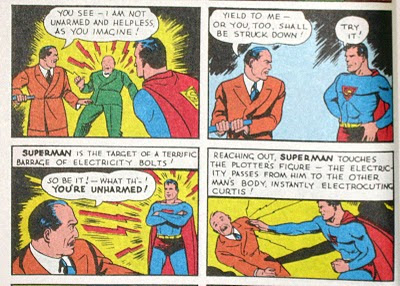The cover of The Superman Chronicles exclaims: “Every Superman story in exact chronological order!”
This volume contains stories from Action Comics #’s 21 – 25 and Superman #’s 4 and 5, as wells as the New York World’s Fair 1940 giveaway, a range in time from Feburary 1940 to “Summer” 1940. Most of the stories are untitled, so DC gave them titles “for reader convenience.”
The stories are so non-canon it’s almost like a different superhero – maybe Kal-el’s distant uncle. In multiple stories Superman either kills the villains, or allows them to die.
Action Comics #22 and #23 are a two part story where Clark and Lois are sent the European country of Luxor as war correspondents. The plot thickens as Clark follows and protects the starlet Lita Laverne (LL!) who turns out to be a spy of some kind. At this point the continuity within the story breaks down as they dock in the country of Toran, a country that plans on invading Galonia. From there Superman gets a chance to join the action, fighting Toranian bombers, submarines, and soldiers. By the end of the issue the headline screams “Korian Army Shake Up!!” with Clark Kent’s byline.
In Action Comics #23 the Toran / Galonia war continues until Superman discovers a secret base deep inside a mountain. He learns that the soldiers are being coerced into the war by a mysterious madman named Lex Luthor. In this first appearance of Luthor he’s a heavy-set fellow with red hair who sits in a wooden throne with what appears to be a German Eagle carved on the backrest. Although he looks different, he still has the superior science: a flying city, voice and image projection machines, and green laser beams. Eventually Supes destroys floating city, apparently killing Luthor, and armistice is declared.
In the next issue Luthor is back, threatening Metropolis with earthquakes unless they meet his demands, a premise that’s pretty similar to Action #21 where the villain used an atomic disintegrator to extort money from the city. The story gets interesting, however, when Superman agrees to a challenge from Luthor: “If your muscles can surpass my scientific feats, I will admit defeat. But if I can outdo you, then you are to retire and leave me a clear path.” Luthor is ruthless in his use of henchmen, letting them die right and left, but I noticed Superman never lifted a hand to save them either.
Other than Luthor most of the villains are gangsters trying to extort, steal and kidnap. In “The Slot Machine Racket” Slug Kelly forces shopkeepers to put out slot machines where kids will waste their nickels. In “Terror in the Trucker’s Union” a mob boss takes over the truck drivers’ union, shutting down food distribution, and holding a hungry city hostage for ransom.
Two stories echo fears of the great depression, only 10 years earlier. In “The Economic Enemy” a financier has architected an economic crisis. As one henchman explains “a foreign nation promised him important concessions if he’ll wreck America’s economic structure! I just work for him!” And in “Luthor’s Incense Machine” the super scientist has created a statue that talks and spits a narcotic incense, which was “placed in the offices of prominent men throughout the nation, thus enslaving them.” I wonder if this was a wry comment by the writer on the US government.
I’d consider “Superman at the World’s Fair” to be the first mature appearance of Superman. The art is less sketchy, more work has been done to detail the backgrounds, and Lois is drawn and written with the personality that’s most familiar to modern readers. Superman has all his trademark traits: he says “up, up!” as he zooms into the sky, the bullets bounce off his chest, and he heaves a car over his head.
My one complaint about this series is that I’d like to see a one or two page introduction giving some insight into the art, writing, editing or even the current events of 1940.
If you’re going to buy any of these series, then this volume, with the introduction of Lex Luthor, and the World’s Fair comic will keep you amused in multiple ways.



No comments:
Post a Comment